Frequently Asked Questions
- Water grass seed for around 45-60 minutes every other day if there is no rain. This should be continued until a season-ending freeze. Then in spring, continue watering until the grass is established
- It doesn’t matter if the lawn is fertilized before or after the lawn has been mowed. The leaves are relatively dry if the fertilizer is applied as a granule, and the grass blades can be seen through the leaf cover. The fertilizer will easily filter through the leaves
- Grubs are the immature form of different beetles, such as Japanese beetles
- Peak grub feeding occurs in early fall. Typically grubs operate a few inches below the soil surface, but burrow deeper (up to 8 inches in northernmost areas) before winter arrives
- Some symptoms of grubs are:
- Irregularly shaped dead patches appear in your well-irrigated lawn in late summer or early fall
- Birds, skunks, raccoons, or moles are tearing up your lawn – they eat grubs and are trying to uncover them
- The best way to identify grubs is visual:
- Pull back a 1′ x 1′ section of grass next to the damaged lawn
- 0–4 grubs: No need to treat.
- 5–8 grubs: No need to treat a healthy lawn unless animals are digging to feed on grubs
- 9 or more: This many grubs will likely create visible damage to a lawn. Plan to treat
- Tips
- Apply a preventative pesticide
- Water in pesticides after application. Watering moves the pesticide down toward soil and also encourages moisture-loving grubs to move upward
- Keep an eye on nearby lawns and repair dead lawn patches by reseeding
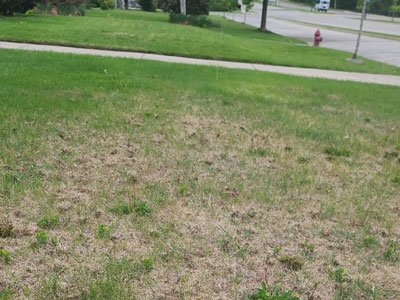
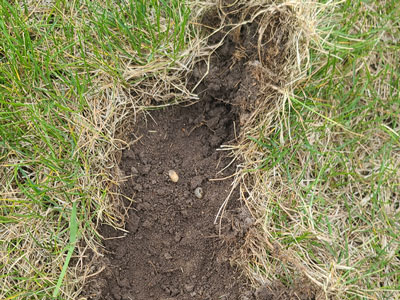

- Heat Stress can be easily misdiagnosed as a chemical burn to an untrained eye.
- Some Heat Stress could look patchy on some lawns compared to other lawns, where it could cover the entire lawn.
- Lawn Bruising is another sign of heat stress. Tires, hoses, trash cans, and even footprints are
among a wide range of things that can cause bruising.
- Lawn Bruising is another sign of heat stress. Tires, hoses, trash cans, and even footprints are
- So, what can you do to protect your lawn?
- Every lawn should get daily water. It is the most important thing you can do to protect your lawn. The best time to water is between 5:00 am and 7:00 am. Some areas of the lawn may need more water compared to other areas of the lawn. An additional short evening watering can help cool soil temperatures and reduce heat and drought stress.
- Proper Mowing is also very crucial to reduce heat stress and bruising. Setting the mower at the highest setting helps keep the lawn cool and helps choke out the weeds. Cutting the lawn short creates more stress for the already stressed lawn
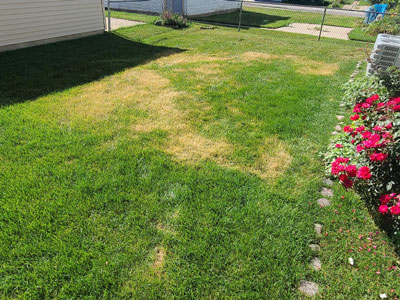
- Bent grass is a non-desirable grass for your lawn. It is a short fine bladed grass that spreads (used on golf course greens).
- Bentgrass can be caused by bird droppings that contain Bentgrass seeds or wind blowing seeds from one property to the next
- Downspouts and common flood/low-lying areas spawn bentgrass too
- The best way to eliminate Bentgrass is to use a short-lasting vegetation killer (Roundup) on the affected area. Then wait 7-10 days, dig out the turf, level with topsoil and reseed the area.
- Be Patient!!!!!
- Grass seed germinates best at 60-80 ℉
- Grass seed takes a minimum of 14 days to germinate; Bluegrass can take up to 28 days.
- The seed needs to come in contact with the soil; raking away dead grass or applying fresh topsoil will help
- For newly seeded areas, straw mats can help retain moisture and stabilize the temperature
- Watering is the most vital step while germinating seed
- The top 1/2 in of soil needs to stay moist (not soaked) at all times for a minimum of 3 weeks
- Typically watering two times a day for 30 mins is sufficient, depending on the time of year and amount of sun a particular area receives
- Dog urine, especially female dogs, is high in nitrogen, salts, and other compounds that, in high quantities can burn your lawn, the same way liquid fertilizer can burn your lawn
- Highly acidic urine can also drastically change the PH levels in your soil, causing constant problems in the affected area. Consult your vet about your dog’s diet
- An application of gypsum or lime will bring the PH to a normal level
- Immediately after your dog urinates, use a garden hose to rinse off the area
- Mushrooms grow in your lawn from decaying wood or organic matter; usually from an old tree stump or dying roots underground
- Mushrooms grow best in wet or damp areas
- Try jamming a rod into the ground to physically break up the decaying matter where mushroom growth seems to be persistent. This may help eliminate mushrooms by allowing airflow to penetrate the decaying matter
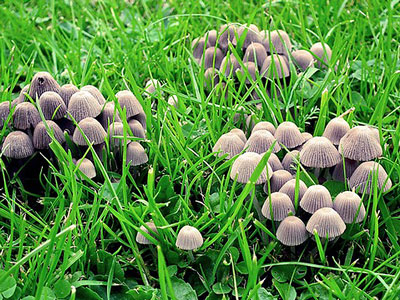
- Deep long, duration watering is best (every other day); to achieve 1” of water per week.
- Irrigation Systems are ideal for keeping your lawn on a proper watering schedule.
- In times of summer droughts or severe heat, water every day and even a second time during mid-evening if necessary.
- Shaded areas don’t require as much water as areas in direct sunlight
- Water early in the morning (5:00 am – 7:00 am). Watering at night can cause fungal diseases and mushrooms. Watering midday can be wasteful due to rapid evaporation from heat and sunlight.

- To reduce weeds in lawns, first understand weeds prefer weakened grass with shallow roots.
- Weeds also need sunlight and nutrients to grow.
- To reduce weeds focus on proper Mowing, Watering, and Fertilizing
- The best way to keep out weeds is proper mowing. When the grass is tall the weeds will not grow because they have no sunlight available
- Keeping your lawn properly watered will reduce thin and bare areas, exactly where weeds will sprout up
- A thick, healthy lawn will naturally deter weeds and will require very small amounts of weed control
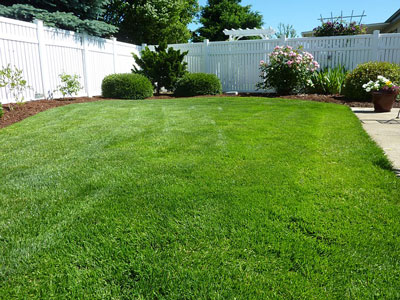
- Mow at least 3″ high
- Don’t cut more than 1/3 of the grass height during one mowing, leaving clumps on your lawn can suffocate grass
- Mulch lawn clippings to recycle nutrients
- Leaving the lawn taller chokes out weeds and promotes deeper roots to help lawns survive droughts
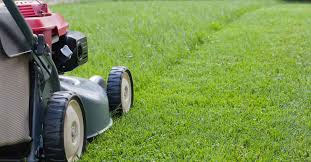
Stay off the lawn until sunset the following day when a pesticide application has been made. If it is just a fertilizer visit there are no restrictions. If your pet needs to use the bathroom it is fine to go on the lawn for a short period but limit it as much as possible.
Mowing the lawn prior to us coming is not necessary. When performing applications 2 and 4 we want as much leaf surface from the broadleaf weeds in your yard to get adequate product on the weeds.
You can mow your lawn any time after sunset the following day.
Watering after a weed control visit is not needed (applications 2 and 4.) Watering after a fertilization treatment will help to release the fertilizer and promote green-up and growth. 1’ of water a week is best to keep your lawn green. YOU MUST WATER IN ALL GRANULAR INSECTICIDE TREATMENTS!
Keeping your lawn tall is best for a happy healthy lawn. 3-3.5” is ideal.
Lawns are a monoculture, and it is hard to keep them weed free. We perform 2 full blanket broadleaf weed applications a season. The products we use require the weeds to be present to treat. Please do not try to pull any weeds out prior to our visits! The program we have setup will get the weeds out of your lawn. If after a visit you are still seeing weeds contact us and we will stop out and take care of it, no charge.
Yes, Granular fertilizers quickly sift through the leaves allowing you to rake anytime following a treatment.
If you received application 1 you most likely do not have crabgrass. One of our staff technicians would be happy to come out and take a look. Tall fescue is often mistaken for crabgrass!
If you notice anything with your lawn that isn’t normal, please contact us.
You can mail us a check at PO Box 26918, Wauwatosa WI 53226 or call us and we can accept a credit card payment. Also, as a customer you have the option of your own customer portal for payment and many other great features. The auto pay option through our online portal is preferred. Call the office today to get it set it up!
